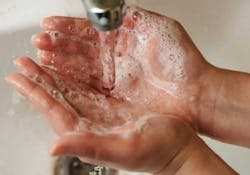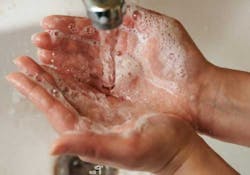Your most important asset
Protect your hands from infection!
by Mary Govoni, CDA, RDA, RDH, MBA
Dental professionals are constantly challenged by the need to practice good hand hygiene vs. protecting the skin of their hands. Hand hygiene procedures not only protect patients, but also the dental professional. But washing hands so many times during the workday can damage skin. Intact skin is an excellent barrier against infectious agents. Dry, cracked skin can serve as a portal for microbes to enter the hands. This article examines current guidelines for hand washing during patient care, selecting hand hygiene products, and recommendations for hand care for dental professionals.
Hand hygiene defined
According to the Centers for Disease Control and Prevention (CDC), hand hygiene procedures are predicated on the type of procedure to be performed. The CDC describes three hand hygiene techniques: hand washing, hand antisepsis, and surgical hand antisepsis. Hand washing is achieved using plain soap and water. Hand antisepsis requires the use of antimicrobial soap and water. Both of these techniques are effective in removing transient microbes from the skin and are appropriate for most dental procedures except surgery. Hand antisepsis can also be achieved by using alcohol-based hand rubs. Surgical hand antisepsis involves an antimicrobial soap that provides persistent activity. Hand wash agents that have persistent activity will not only remove transient microbes from the skin, but will inhibit the regrowth of microbes that live on the skin, called resident microbes.
Types of hand hygiene products
While plain soap may be appropriate in some dental health care settings, soap with antimicrobial properties is preferred for nonsurgical procedures. Liquid or powdered soap is appropriate, but not bar soap. Bar soap is a reservoir for microbes to colonize. Antimicrobial soaps contain compounds such as triclosan, chloroxylenol (PCMX), chlorhexidine, or iodine. Surgical hand wash agents may be the same products as those used for hand antisepsis, but the duration of the procedure is two to six minutes. The minimum time recommended for hand washing and hand antisepsis is 15 seconds, although up to 60 seconds is preferred.
Alcohol-based hand rubs may be used instead of plain and antimicrobial soaps, except when there is debris on the hands. These products do not effectively remove debris from the skin, which may prevent the alcohol from contacting the skin and reducing the number if microbes. Some alcohol-based products contain other antimicrobial agents, such as triclosan or chlorhexidine, which provide the user with persistent activity. In some cases these products are used after plain soap for a surgical hand-scrub procedure.
Hand wash agents, whether soap or alcohol-based, can dry hands. Also, some dental professionals experience skin sensitivity caused by the ingredients in hand wash agents. Therefore, hand hygiene agents should be carefully selected. The use of plain soap typically provides the least skin irritation, protecting the hands from cracking or drying and decreasing the risk of infection through openings in the skin. But the trade-off for using plain soap is no persistent activity. Alcohol-based products can be very drying to the skin. When selecting these products, look for those that also contain moisturizers.
Not only is the selection and use of hand hygiene products important in infection prevention, maintenance of soap containers is also critical. Liquid soap dispensers can become contaminated, and the soap can serve as a reservoir for the growth of microbes. When a dispenser is empty, it should be thoroughly cleaned and dried before being refilled, or disposable dispensers can be used. Liquid soap containers should not be "topped off" when partially empty.
Gloves vs. hand washing
A common misconception about hand hygiene in dental health care is that glove use is a substitute for hand washing. According to the CDC, dental professionals should wash their hands prior to donning gloves and immediately after removing gloves. Gloves can develop micro tears that allow contaminants to leak through to the skin, which makes it very important to wash hands after removing gloves. It's important to follow washing the hands prior to donning gloves with thorough drying of the hands. Moisture on the skin inside the gloves promotes regrowth of microbes on the skin and can cause skin irritation.
Skin care
Moisturizing lotions are critical for dental professionals to counteract the drying effect of continuous washing, which removes some of the natural oils from the skin. This is especially important in cold weather, when skin tends to dry out even more. Hand lotions that contain petroleum products last longer on the skin, but can weaken latex gloves. Therefore these products should be used only at the end of the workday if latex gloves are worn during the day.
At work, other long-lasting lotions that do not compromise latex gloves should be used. These lotions contain silicone or natural oils such as olive oil. Many also contain aloe vera, a proven healing agent for skin. Some also contain vitamin E and other ingredients that are effective in wound healing.
Special attention should be given to the cuticles, since this is a common area to develop cracks or cuts. Cuticle oils or creams should be used several times a day to prevent cracking or hangnails.
Resources
The CDC Web site (www.cdc.gov) is an excellent source for information about hand hygiene. Among the resources are downloadable posters about hand washing with soap and water, as well as alcohol hand rubs. (See Figures 1 and 2.) These can serve as excellent references in dental facilities. The CDC Guidelines for Hand Hygiene in Health Care Settings 2002 reference a large body of research about the effectiveness of various antimicrobial agents and alcohol-based products. These guidelines also contain recommendations for increasing compliance with hand hygiene protocols. Another helpful resource is the Association for Professionals in Infection Control (APIC - www.apic.org).
Summary
Although hand hygiene is considered one of the most effective infection prevention protocols, it can damage the integrity of the skin. Carefully select hand wash products based on the type of procedure to be performed and the effect on the skin. Maintain the skin and counteract the drying effects of continuous hand washing by frequently applying lotions, but avoid petroleum-based lotions or creams when using latex gloves. Following these recommendations will help protect one of your most valuable assets – your hands.
Mary Govoni, CDA, RDA, RDH, MBA, is the owner of Clinical Dynamics, a consulting company based in Michigan. She is a member of the Organization for Safety and Asepsis Procedures. She can be contacted at [email protected] or visit www.marygovoni.com.
References
1. Centers for Disease Control and Prevention; Guidelines for Infection Control in Dental Health-Care Settings, 2003.
2. Centers for Disease Control and Prevention; Guidelines for Hand Hygiene in Health Care Settings, 2002
Past RDH Issues



